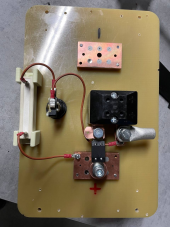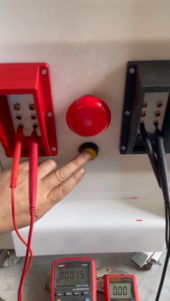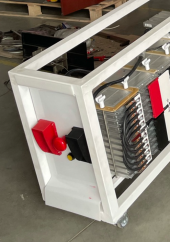Correct. Any time I pull the batteries, the inverter is turned off first.Being 4 hours south of you, I am essentially in the same boat. I have my batteries in a rack made by Overkill Solar and they connect to a master Perko battery switch with Pre-charge, as designed by Filter Guy. My battery pack comes out with the disconnection of the +/- cables. Do you use your inverter for AC pass through when your battery is out of the van, a question because if not, your inverter was turned off when you removed your batteries, no? Your plans, as noted before, are a thing of beauty.
You are using an out of date browser. It may not display this or other websites correctly.
You should upgrade or use an alternative browser.
You should upgrade or use an alternative browser.
Will this work for pre-charging inverter capacitors?
- Thread starter krby
- Start date
Keith C
Ahhh, the sharks have him.
Moving battery packs.... gack! Let me ask, since you have solar why not just run a thermostatically controlled fan to keep the vehicle just barely north of ambient? That provides help to more than just the batteries. It helps the windshield, all the other electronics, any plastics, the upholstery, etc. If the sun is out the solar is providing.
Going to do that as well. I have a 14" MaxxAir ventilation fan in the ceiling of my van, powered from the load output of my SCC. This is going to be running any time there is daylight shining on the van.Moving battery packs.... gack! Let me ask, since you have solar why not just run a thermostatically controlled fan to keep the vehicle just barely north of ambient? That provides help to more than just the batteries. It helps the windshield, all the other electronics, any plastics, the upholstery, etc. If the sun is out the solar is providing.
The problem is ambient temperature gets over 120 degrees here in the summer. Add heat build up inside a vehicle and who knows how hot it could get in there.
One of the advantage lithium batteries have over lead/acid is they are a lot lighter in weight and I intend to take advantage of that. I am building a sliding tray into my electrical garage for the battery. The battery connects into the system using an Anderson SB175 connector. When the van is not in use in the summer, I will slide the battery out of its compartment, unplug it, then lift it onto a wheeled cart and roll it into the cool air conditioned house.
Mex Rider
Solar Enthusiast
- Joined
- Oct 27, 2019
- Messages
- 290
We can't get anywhere close to 30 c! I've got two maxxair fans but if parked in the sun for solar the outside sheetmetal is approaching 130f!Going to do that as well. I have a 14" MaxxAir ventilation fan in the ceiling of my van, powered from the load output of my SCC. This is going to be running any time there is daylight shining on the van.
The problem is ambient temperature gets over 120 degrees here in the summer. Add heat build up inside a vehicle and who knows how hot it could get in there.
One of the advantage lithium batteries have over lead/acid is they are a lot lighter in weight and I intend to take advantage of that. I am building a sliding tray into my electrical garage for the battery. The battery connects into the system using an Anderson SB175 connector. When the van is not in use in the summer, I will slide the battery out of its compartment, unplug it, then lift it onto a wheeled cart and roll it into the cool air conditioned house.
160 degree F (70 degrees C) is typical inside a parked car with the windows rolled up in the summer.We can't get anywhere close to 30 c! I've got two maxxair fans but if parked in the sun for solar the outside sheetmetal is approaching 130f!
Let's just say, leather upholstery is a terrible idea in Phoenix if your car is parked in the sun. You can get branded if you jump in without taking care. I don't wear shorts in the summer.
When getting a resistor, should the watts on the resistor match up to the inverter you have. For example in Will's video he had a 25watt 30ohm resistor using on a 24v inverter. Not sure if I should downsize that if I am using a 12v system to say 13 watts?
Ampster
Renewable Energy Hobbyist
I think the Watts is based ln the voltage and the resistor value. Those are the two parts or Ohms law that would allow you to calculate current. Then you would multiply current times volts to get Watts. The other unknown is the uF capacity of Capacitor which may determine how long it will be carrying that current. From what I have read on this thread the surge might not be long and the current would drop off quickly if the resistance was not too high. I googled it once and the perfect match is a complicated formula. Generally a higher voltage would take a higher resistance if you want a reasonable time.When getting a resistor, should the watts on the resistor match up to the inverter you have. For example in Will's video he had a 25watt 30ohm resistor using on a 24v inverter. Not sure if I should downsize that if I am using a 12v system to say 13 watts?
Earlier in this thread someone was using a 66 Ohm resitor for 12 volts and the conclusion was the capacitor was not getting fully charged in ten seconds, whereas it was working quickly on a 48 volt inverter.
Subsequently @rmaddy posted a link to a document that for a 12 volt circuit a resistor from 6 to 10 Ohms (25 Watt) might work in 10 or 15 seconds.
Last edited:
When getting a resistor, should the watts on the resistor match up to the inverter you have. For example in Will's video he had a 25watt 30ohm resistor using on a 24v inverter. Not sure if I should downsize that if I am using a 12v system to say 13 watts?
See post #181. That document covers the resistor size for 12V - 48V.
sibianul
New Member
- Joined
- Apr 29, 2020
- Messages
- 11
Farmgirl0527
New Member
- Joined
- Dec 29, 2019
- Messages
- 83
Don't want to sound crude, but I use a 110v electric light bulb.
MisterSandals
Participation Medalist
Lets see some pix!Don't want to sound crude, but I use a 110v electric light bulb.
Farmgirl0527
New Member
- Joined
- Dec 29, 2019
- Messages
- 83
Sorry but I did this on my 12kw signeer inverter which has been running for 3 years now. No need to redo it. If making a box works for you, go at it. Just think about what light build actually does, a resister that glows.
efficientPV
Solar Addict
- Joined
- Sep 24, 2019
- Messages
- 1,351
I can't believe how people are milking this idea here. One sentence and it should have been done.
Don't want to sound crude, but I use a 110v electric light bulb.
Of course that works but it’s hard to beat a free resistor like post 209 has. Very clean setup.
Hey guys, just wanted to ask a question on what resistor I can use.
I'm able to find a 30ohm 10w or 50w resistor. If I'm correst the ohm's are what matter, the wattage is how fast the cappasitors will charge correct?
My inverter is a 12v 3000va Victron Multiplus 2. Which resistor will be best to pre charge the caps?
Thanks!
I'm able to find a 30ohm 10w or 50w resistor. If I'm correst the ohm's are what matter, the wattage is how fast the cappasitors will charge correct?
My inverter is a 12v 3000va Victron Multiplus 2. Which resistor will be best to pre charge the caps?
Thanks!
12v inverters aren’t critical to use a resistor. The voltage is low, so the charging rate of the capacitors is small. There will be a spark, but it is unlikely to cause any damage.Hey guys, just wanted to ask a question on what resistor I can use.
I'm able to find a 30ohm 10w or 50w resistor. If I'm correst the ohm's are what matter, the wattage is how fast the cappasitors will charge correct?
My inverter is a 12v 3000va Victron Multiplus 2. Which resistor will be best to pre charge the caps?
Thanks!
24 and higher V inverters have a massive spark, able to fry BMS, and switches etc.
Hey,12v inverters aren’t critical to use a resistor. The voltage is low, so the charging rate of the capacitors is small. There will be a spark, but it is unlikely to cause any damage.
24 and higher V inverters have a massive spark, able to fry BMS, and switches etc.
Thanks... I was thinking the same but wantes to ask you guys. In the event that I still want to pre charge them, just in case, can I use the resistor I described above?
Thanks!
MisterSandals
Participation Medalist
Either will work just fine. The 50W will not get as hot/warm as the 10W so I would use 50W given a choice. Both equally capable for your purpose.Hey,
Thanks... I was thinking the same but wantes to ask you guys. In the event that I still want to pre charge them, just in case, can I use the resistor I described above?
Thanks!
Thanks so much! Quiality help, much approciated!Either will work just fine. The 50W will not get as hot/warm as the 10W so I would use 50W given a choice. Both equally capable for your purpose.
Similar threads
- Replies
- 1
- Views
- 117
- Replies
- 6
- Views
- 543
- Replies
- 7
- Views
- 420






